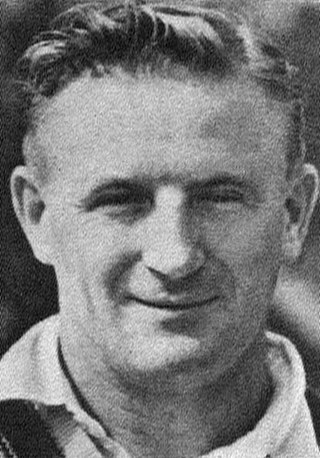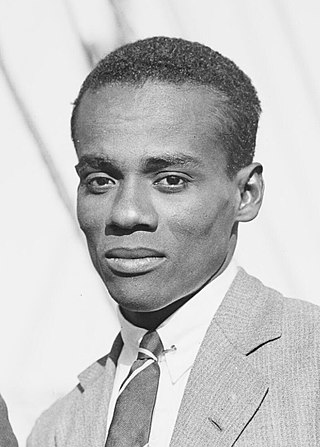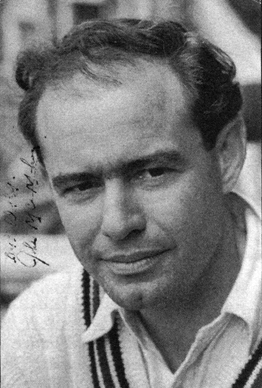
James Charles Laker was an English professional cricketer who played for Surrey County Cricket Club from 1946 to 1959 and represented England in 46 Test matches. He was born in Shipley, West Riding of Yorkshire, and died in Wimbledon, London.

Sydney Francis Barnes was an English professional cricketer who is regarded as one of the greatest bowlers of all time. He was right-handed and bowled at a pace that varied from medium to fast-medium with the ability to make the ball both swing and break from off or leg. In Test cricket, Barnes played for England in 27 matches from 1901 to 1914, taking 189 wickets at 16.43, one of the lowest Test bowling averages ever achieved. In 1911–12, he helped England to win the Ashes when he took 34 wickets in the series against Australia. In 1913–14, his final Test series, he took a world record 49 wickets in a Test series, against South Africa.
John Brian Statham, was an English professional cricketer from Gorton, in Manchester, who played for Lancashire County Cricket Club from 1950 to 1968 and for England from 1951 to 1965. As an England player, he took part in nine overseas tours from 1950–51 to 1962–63. He was a right arm fast bowler and was noted for the consistent accuracy of his length and direction.

Colin Leslie McCool was an Australian cricketer who played in 14 Test matches between 1946 and 1950. McCool, born in Paddington, New South Wales, was an all-rounder who bowled leg spin and googlies with a round arm action and as a lower order batsman was regarded as effective square of the wicket and against spin bowling. He made his Test début against New Zealand in 1946, taking a wicket with his second delivery. He was part of Donald Bradman's Invincibles team that toured England in 1948 but injury saw him miss selection in any of the Test matches.

Johnny Wardle was an English spin bowling cricketer whose Test Match career lasted between 1948 and 1957. His Test bowling average of 20.39 is the lowest in Test cricket by any recognised spin bowler since the First World War.
Gary Keedy is a retired English cricketer. A slow-left arm spin bowler, he played one match for Yorkshire in 1994, having graduated from their cricket academy, before moving to Lancashire in 1995. He played for the club until 2012 taking over 500 first-class wickets. Although he had played youth internationals, he never played for the senior England team, although he was named in the squad a few times. In 2011 he was part of the Lancashire squad that won the County Championship for the first time since 1950. Keedy subsequently played one season for Surrey and two for Nottinghamshire before retiring as a professional cricketer in 2015. After studying physiotherapy at the University of Salford, he is currently Nottinghamshire's spin bowling coach and assistant physiotherapist.
Roy Tattersall was an English cricketer who played for Lancashire and played sixteen Tests for England as a specialist off spin bowler. He was born at Tonge Moor, Bolton, Lancashire, England.
Richard Pollard was an English cricketer born in Westhoughton, Lancashire, who played in four Test matches between 1946 and 1948. A fast-medium right-arm bowler and a lower-order right-handed batsman who made useful runs on occasion, he played for Lancashire between 1933 and 1950, taking 1,122 wickets in 298 first-class matches; he is 10th highest wicket-taker for Lancashire.

Edwin Lloyd St Hill was a Trinidadian cricketer who played two Test matches for the West Indies in 1930. His brothers, Wilton and Cyl, also played for Trinidad and Tobago; in addition, the former played Test matches for the West Indies.
1907 was the 18th season of County Championship cricket in England. Nottinghamshire won their first official title. England played their sixth Test series against South Africa but it was the first to be held in England.

John Crossland was an English professional cricketer who played first-class cricket between 1878 and 1887. Crossland was recognised as one of the fastest bowlers in county cricket, but critics generally believed that he threw, rather than bowled the ball, a practice illegal in cricket. Contemporaries suggest that, but for the suspicions over his bowling action, Crossland would have played Test cricket for England.
Arnold Hamer was a first-class cricketer, who played for Yorkshire in 1938, and for Derbyshire between 1950 and 1960, scoring over 15,000 runs in first-class cricket. He also played as a footballer, playing eight games for York City in 1938.
Bernard Leonard Muncer was a cricketer who played for Middlesex and Glamorgan.
John Lawrence was a diminutive Yorkshire-born cricketing all-rounder whose middle or lower order batting and leg-break and googly bowling were of great importance to Somerset in the 10 cricket seasons immediately after the Second World War.
James Horsley was an English cricketer who played first-class cricket for Nottinghamshire in 1913 and for Derbyshire from 1914 to 1925
Albert Ennion Groucott Rhodes, universally known as "Dusty" Rhodes, was an English cricketer who played first-class cricket for Derbyshire County Cricket Club between 1937 and 1954 and was also a Test match umpire.

Frank Henry Vigar was an English cricketer who played first-class cricket for Essex County Cricket Club between 1938 and 1954. A right-handed batsman, and leg break bowler, Vigar served as an all-rounder with 8,858 runs at 26.28 and 241 wickets at 37.90. From his rained-off debut in 1938, Vigar went on to play 257 matches for his county. His greatest success came in the "golden summer" of 1947, where he scored 1,735 runs and took 64 wickets. A partnership with Peter Smith of 218 for the final wicket remains an Essex record.

John William Joseph McMahon was an Australian-born first-class cricketer who played for Surrey and Somerset County Cricket Clubs in England from 1947 to 1957.
Richard Horsfall was an English cricketer, who played first-class cricket for Essex between 1947 and 1955, and then played for a single season for Glamorgan in 1956. He was a right-handed middle-order batsman.
Raymond Bernard Strauss was an Australian sportsman who played both cricket and field hockey at high levels. From Perth, Western Australia, Strauss attended Perth Modern School and later the University of Western Australia, playing for the university's hockey club. Twice named captain of the all-Australian universities side, he was captain of the side on several occasions, including when the team shared the 1952 Syme Cup with the University of Adelaide. Strauss represented Western Australia on various occasions from 1949 to 1955, and made his Test debut for the Australian national team in August 1954, against New Zealand, though it is unclear if he played further matches for the national side. At both club and state levels, he had largely played as a defender, usually as a fullback, and was known for his "interceptions and long clearances".








